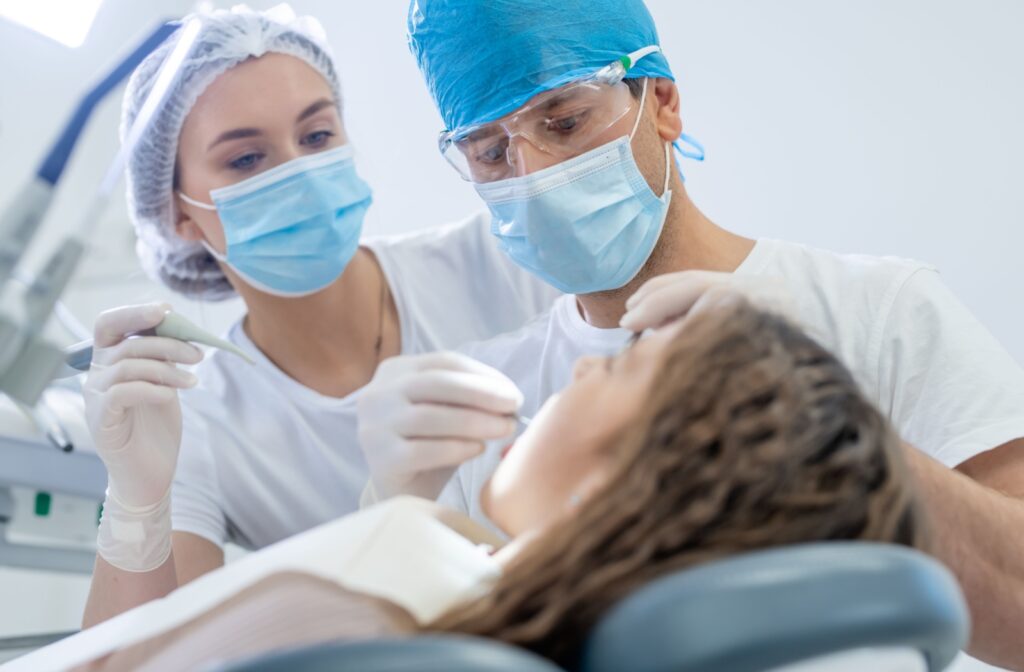
The thought of having a tooth pulled can bring up a lot of questions about your overall oral health. You might wonder what the process is like and, more importantly, what to expect during recovery. Getting to know your friendly, caring dental team can also help you feel more prepared and confident about the procedure.
Your healing journey happens in stages, with each day bringing you closer to feeling like yourself again.
Most people feel back to normal within 1–2 weeks, but the first few days are the most important for a smooth recovery. Following a clear timeline and aftercare instructions can help you heal comfortably and effectively.
Why You Might Need an Extraction & How We Help You Stay Comfortable
A tooth extraction is a common procedure that can protect your overall oral health. Whether it’s a wisdom tooth that has no room to grow or a damaged tooth, the goal is always your well-being.
Reasons for a Regular Tooth Extraction
Sometimes, a tooth needs to be removed to keep your other teeth and gums healthy. This can happen for a few different reasons. Common situations include:
- A tooth with significant decay
- Advanced gum disease that has loosened a tooth
- A tooth that is broken or cracked beyond repair
- Crowded teeth that need more space
Reasons for a Wisdom Tooth Extraction
Wisdom teeth, or third molars, often need to be removed during the late teens or early twenties. They are the last teeth to come in, and there isn’t always enough room for them.
An extraction might be suggested if you experience pain, infection, or if they pose a risk to your other teeth.
A Focus on Your Comfort
We understand that you may feel anxious about an extraction, and we have options to help you feel relaxed. Local anesthesia numbs the specific area so you won’t feel pain during the procedure. For those who need a little extra help to feel at ease, sedation dentistry options can provide a deeper state of relaxation while you remain conscious.
The First 48 Hours: Your Immediate Recovery
The first 2 days after your procedure are crucial for a successful healing process. Your main job is to rest and let a protective blood clot form in the empty tooth socket. This clot is the foundation for your body’s natural healing process, and following our detailed post-operative instructions is key to protecting it.
The First 24 Hours: The Clot Forms
Take it easy and focus on these simple steps to protect the extraction site. You can expect some minor swelling and bleeding, which is a normal part of healing. To manage this, you can:
- Bite gently on the provided gauze pad.
- Apply an ice pack to your cheek for 10–20 minutes at a time.
- Avoid rinsing your mouth, spitting, or using a straw.
- Get plenty of rest to let your body heal and avoid any potential dental emergencies.
Rest & Continued Recovery
Plan to rest for at least 24 hours after your procedure. If you have a physically demanding job, you may want to take an extra day or 2 off. By days 2 and 3, swelling should begin to go down, and you can start to gently rinse your mouth with warm salt water to keep it clean.
The First Week: A Return to Routine
After about 3 days, you can slowly begin to reintroduce more of your normal activities. The extraction site has begun to heal, but it’s still important to be gentle with it. Your focus now is on keeping the area clean and eating foods that won’t disrupt the healing socket.
What to Eat & Drink
Proper nutrition can support your body’s healing process. For the first week, it’s best to stick to a soft-food diet. This helps you get the nutrients you need without disturbing the extraction site.
- Choose soft foods like yogurt, soup, mashed potatoes, and smoothies.
- Avoid hot liquids, alcohol, and crunchy or hard foods.
- Stay hydrated by drinking plenty of water—just remember not to use a straw.
How to Keep Your Mouth Clean
Keeping your mouth clean is important. You can gently brush and floss your other teeth as you normally would, being gentle around the healing area. Gently rinsing with a warm salt water solution a few times a day can also help keep the area clean and comfortable.

Long-Term Healing & How to Support It
As you move into the second week and beyond, your body continues the healing process. New gum tissue will form over the socket, and you’ll start to feel much more like yourself. Supporting this final stage of recovery is straightforward.
Weeks 2–4: New Tissue Forms
By the second week, the blood clot should be stable, and new gum tissue should be covering the site. If you received stitches that don’t dissolve on their own, you may need to book a follow-up appointment to have them removed. The area might still be a little tender, but it is well on its way to healing.
How Long Until You Feel Normal Again?
Most people feel completely back to normal within 1–2 weeks, especially after a simple extraction.
Healing from wisdom tooth removal can sometimes take a bit longer. The gum tissue over the socket typically closes within 3–4 weeks, while the underlying bone will continue to heal for a few months.
Tips for a Smooth Recovery
You play a big part in your own healing. Supporting a smooth recovery is easier when you get enough rest, stay hydrated, and avoid smoking, all of which help your body heal well.
Potential Concerns & Your Long-Term Oral Health
While most recoveries are straightforward, it’s helpful to know what to watch for. Being aware of the signs of potential issues can give you peace of mind. Remember, your oral health journey continues long after the extraction site has healed.
How to Know If a Dry Socket Forms
A dry socket is one of the more common oral health complications and occurs if the protective blood clot is dislodged before the socket has healed. This can happen due to certain activities, such as forceful spitting, vigorous rinsing, or using a straw, which creates suction and can pull the clot out of place. The main signs include:
- Pain that gets worse instead of better after the third day.
- Pain that radiates from the socket toward your ear.
- A bad taste or odour coming from the extraction site.
When to Contact Your Dentist
If you suspect a dry socket or experience other unusual symptoms, it is important to contact your dentist. The risk is highest in the first few days and decreases significantly after a week. You should also get in touch if you experience a fever, nausea, persistent bleeding, or swelling that gets worse over time.
Comfortable Tooth Extractions in Lethbridge
An extraction is just one part of your overall dental wellness. Regular check-ups with your dentist in Lethbridge are a great way to monitor your oral health and prevent future issues. These visits allow us to check on your healing and partner with you for a lifetime of healthy smiles.
Our team at Cool Dental is dedicated to providing you with a comfortable and caring experience. If you have questions about tooth extractions or your oral health, we invite you to connect with us.
We’re here to give you more to smile about.


